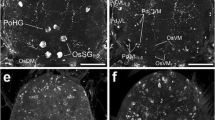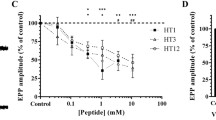Abstract
Ticks are ectoparasites of medical and veterinary importance, which transmit many infectious agents, causing significant damage to the hosts. The “dog tick” Rhipicephalus sanguineus is responsible for transmitting several pathogens to dogs, motivating researchers to investigate efficient and sustainable control methods. Currently, chemical acaricides currently in use target the central nervous system (synganglion), which is responsible for controlling all the systemic functions of the ticks. Here, the neurotoxic potential of deltamethrin on the synganglion of unfed R. sanguineus female ticks was investigated. The results showed that the synganglion of the females belonging to the control group presented intact morphological characteristics; however, the ones from the treatment group (exposed to 1.5, 3.12 and 6.25 ppm of deltamethrin) displayed alterations, which were increasingly intense as the concentration increased. Observed alterations were mainly in the cortex region and in the neuropile, indicating that the deltamethrin is neurotoxic.

Similar content being viewed by others
References
Arnosti A, Brienza PD, Chierice GO et al (2011a) Effects of Ricinus communis oil esters on salivary glands of Rhipicephalus sanguineus (Latreille 1806 Acari: Ixodidae). Exp Parasitol 127:569–574
Arnosti A, Brienza PD, Furquim KCS et al (2011b) Effects of ricinoleic acid esters from castor oil of Ricinus communis on the vitellogenesis of Rhipicephalus sanguineus (Latreille, 1806) (Acari:Ixodidae) ticks. Exp Parasitol 127:575–580
Borges LMF, Soares SF, Fonseca IN et al (2007) Resistência carrapaticida em larvas de Rhipicephalus sanguineus (Acari: Ixodidae) de Goiânia-GO, Brasil. Rev Patol Trop 36:87–95
Crampton AL, Baxter GD, Barker SC (1999) Identification and characterization of a cytochrome P450 gene and processed pseudogene from an arachnid: the cattle tick, Boophilus microplus. Insect Biochem Mol Biol 29:377–384
Dantas-Torres F (2010) Biology and ecology of the brown dog tick, Rhipicephalus sanguineus. Parasit Vectors 3:1–11
Demma LJ, Traeger MS, Nicholson WL et al (2005) Rocky Mountain spotted fever from an unexpected tick vector in Arizona. N Engl J Med 353:587–594
Denardi SE, Bechara GH, Oliveira PR, Camargo-Mathias MI (2011) Inhibitory action of neem aqueous extract (Azadirachta indica A. Juss) on the vitellogenesis of Rhipicephalus sanguineus (Latreille, 1806) (Acari: Ixodidae) ticks. Microsc Res Tech 74:889–899
Elliott M, Janes NF, Potter C (1978) The future of pyrethroids in insect control. Annu Rev Entomol 23:443–469
Farias MPO, Sousa DP, Arruda AC et al (2007) Eficácia in vitro do óleo da Carapa guianensis Aubl. (andiroba) no controle de Boophilus microplus (Acari: Ixodidae). Rev Bras Plantas Med 9:68–71
Fernandes FF, Freitas EP, Silva JR et al (2001) Toxic effects and in vitro inefficacy of deltamethrin on larvae of Rhipicephalus sanguineus from Goiania, Goias, Brazil. Rev Soc Bras Med Trop 34:159–165
Flechtmann CHW (1973) Ácaros de importância médico-veterinária. Livraria Nobel SA, São Paulo
Frazzon APG, Junior IDSV, Masuda A et al (2000) In vitro assessment of Metarhizium anisopliae isolates to control the cattle tick Boophilus microplus. Vet Parasitol 94:117–125
Freitas DRJ, Pohl PC, Vaz-Junior IS (2005) Caracterização da resistência para acaricidas no carrapato Boophilus microplus. Acta Sci Vet 33:109–117
Furquim KCS, Bechara GH, Camargo-Mathias MI (2008a) Death by apoptosis in salivary glands of females of the tick Rhipicephalus sanguineus (Latreille, 1806) (Acari:Ixodidae). Exp Parasitol 119:152–163. doi:10.1016/j.exppara.2008.01.021
Furquim KCS, Bechara GH, Camargo-Mathias MI (2008b) Degeneration of salivary glands of males of the tick Rhipicephalus sanguineus (Latreille, 1806) (Acari, Ixodidae). Vet Parasitol 154:325–335. doi:10.1016/j.vetpar.2008.03.013
Hitchner SB, Domermuth CH, Purchase HG, Williams JE (1975) Isolation and identification of avian pathogens. Arnold Printing Corporation, New York
Horn SC (1983) Prováveis prejuízos causados pelos carrapatos (Boletim de Defesa Sanitária). Ministério da Agricultura, Brasília
Jongejan F, Uilenberg G (2004) The global importance of ticks. Parasitology 129:S3–S14. doi:10.1017/S0031182004005967
Junqueira LCU, Junqueira LMMS (1983) Técnicas básicas de citologia e histologia. Livraria Editora Santos, São Paulo
Marzouk AS, Mohamed FSA, Omar NR (2001) Fine structure of the synganglion of unfed female Rhipicephalus (Rhipicephalus) sanguineus (Latreille) (Ixodoidea: Ixodidae). J Egypt Soc Parasitol 31:1–12
Nodari EF, Roma GC, Furquim KCS et al (2011) Cytotoxic effects of permethrin in salivary glands of Rhipicephalus sanguineus (Latreille, 1806) (Acari: Ixodidae) semi-engorged females. Exp Parasitol 128:151–158
Nodari EF, Roma GC, Furquim KCS et al (2012a) Action of permethrin on Rhipicephalus sanguineus (Latreille, 1806) (Acari: Ixodidae) semi-engorged females: Morpho-physiological evaluation of salivary glands. Ticks Tick Borne Dis 3:219–226
Nodari EF, Roma GC, Furquim KCS, Camargo-Mathias MI (2012b) Degenerative process and cell death in salivary glands of Rhipicephalus sanguineus (Latreille, 1806) (Acari: Ixodidae) semi-engorged female exposed to the acaricide permethrin. Microsc Res Tech 75:1012–1018. doi:10.1002/jemt.22025
Nolan J (1985) Mechanisms of resistance to chemicals in arthropod parasites of veterinary importance. Vet Parasitol 18:155–166
Oliveira PR, Bechara GH, Camargo-Mathias MI (2008) Evaluation of cytotoxic effects of fipronil on ovaries of semi-engorged Rhipicephalus sanguineus (Latreille, 1806) (Acari: Ixodidae) tick female. Food Chem Toxicol 46:2459–2465
Oliveira PR, Bechara GH, Marin-Morales MA, Camargo-Mathias MI (2009) Action of the chemical agent fipronil on the reproductive process of semi-engorged females of the tick Rhipicephalus sanguineus (Latreille, 1806) (Acari: Ixodidae). Ultrastructural evaluation of ovary cells. Food Chem Toxicol 47:1255–1264
Oliveira PR, Remédio RN, Bechara GH et al (2015) Dinotefuran-induced morphophysiological changes in the ovaries and midgut of semi-engorged females Rhipicephalus sanguineus Latreille, 1806 (Acari: Ixodidae) ticks. Parasitol Res 115:829–849. doi:10.1007/s00436-015-4814-3
Pereira MC, Labruna MB, Szabó MPJ, Klafke GM (2008) Rhipicephalus (Boophilus) microplus: biologia, controle e resistência. MedVet, São Paulo
Pereira CPM, Oliveira PR, Bechara GH, Camargo-Mathias MI (2009) Effects of fipronil (active ingredient of Frontline®) on salivary gland cells of Rhipicephalus sanguineus (Latreille, 1806) (Acari: Ixodidae) females. Vet Parasitol 166:124–130
Pereira CPM, Oliveira PR, Furquim KCS et al (2011) Fipronil-induced cell death in salivary glands of Rhipicephalus sanguineus (Latreille, 1806) (Acari: Ixodidae) semi-engorged females. Exp Parasitol 127:481–489. doi:10.1016/j.exppara.2010.10.003
Pruett JH (1999) Immunological control of arthropod ectoparasites: a review. Int J Parasitol 29:25–32
Prullage JB, Pound JM, Meola SM (1992) Synganglial morphology and neurosecretory centers of adult Amblyomma americanum (L.) (Acari: Ixodidae). J Med Entomol 29:1023–1034
Roma GC, Oliveira PR, Pizano MA, Camargo-Mathias MI (2009) Determination of LC 50 of permethrin acaricide in semi-engorged females of the tick Rhipicephalus sanguineus (Latreille, 1806) (Acari: Ixodidae). Exp Parasitol 123:269–272
Roma GC, Furquim KCS, Bechara GH, Camargo-Mathias MI (2010) Permethrin-induced morphological changes in oocytes of Rhipicephalus sanguineus (Acari: Ixodidae) semi-engorged females. Food Chem Toxicol 48:825–830
Roma GC, Nunes PH, Oliveira PR et al (2012a) Central nervous system of Rhipicephalus sanguineus ticks (Acari: Ixodidae): an ultrastructural study. Parasitol Res 111:1277–1285
Roma GC, Nunes PH, Remédio RN, Camargo-Mathias MI (2012b) Synganglion histology in different stages of Rhipicephalus sanguineus ticks (Acari: Ixodidae). Parasitol Res 110:2455–2463. doi:10.1007/s00436-011-2785-6
Roma GC, Camargo-Mathias MI, Oliveira PR et al (2013) Neurotoxic action of permethrin in Rhipicephalus sanguineus (Latreille, 1806) (Acari: Ixodidae) female ticks. Morphological and cytochemical evaluation of the central nervous system. Vet Parasitol 196:482–491. doi:10.1016/j.vetpar.2013.02.025
Roma GC, Camargo-Mathias MI, Nunes PH, Bechara GH (2014) Ultrastructure of the synganglion in the larvae and nymphs of tick Rhipicephalus sanguineus (Latreille, 1806)(Acari: Ixodidae). Int J Acarol 40:207–213
Ruppert EE, Fox RS, Barnes RD (2004) Invertebrate zoology: a functional evolutionary approach, 7th edn. Thomson-Brooks/Cole, Belmont
Sonenshine DE, Roe RM (2014) Biology of ticks, vol 1. Oxford University Press, New York
World Health Organization (2004) The vector-borne human infections of Europe: their distribution and burden on public health. WHO Regional Office for Europe, Copenhagen
Acknowledgments
The authors are grateful to the Fundação de Amparo à Pesquisa do Estado de São Paulo-FAPESP (Grant: 2015/20745-6) and to the Conselho Nacional de Desenvolvimento Científico e Tecnológico-CNPq (Grant: 300625/2012-0), M.I. Camargo-Mathias academic carrier research fellowship for the financial support. The authors would like to thank Mr. Gerson de Mello Sousa for technical support.
Author information
Authors and Affiliations
Corresponding author
Ethics declarations
Conflict of interest
The authors declare that there are no conflicts of interest.
Rights and permissions
About this article
Cite this article
Pereira, M.C., Gasparotto, A.E., Jurgilas, J.P. et al. Detrimental effect of deltamethrin on the central nervous system (synganglion) of Rhipicephalus sanguineus ticks. Exp Appl Acarol 71, 159–169 (2017). https://doi.org/10.1007/s10493-017-0109-y
Received:
Accepted:
Published:
Issue Date:
DOI: https://doi.org/10.1007/s10493-017-0109-y




